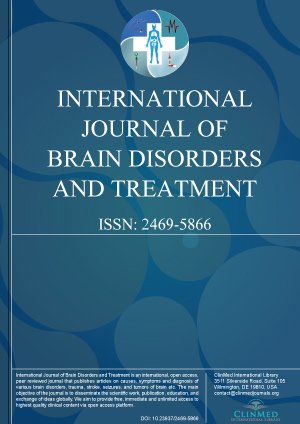Open Access DOI:10.23937/2469-5866/1510012
Decreased Hippocampal Volume is Related to White Matter Abnormalities in Treatment-Resistant Depression
Christina B Young, Philip van Eijndhoven, Robin Nusslock, Guillen Fernandez, Aart Schene, Christian F Beckmann and Indira Tendolkar
Article Type: Original Article | First Published: June 22, 2016
Despite considerable research on the pathophysiology of unipolar depression, relationships between gray and white matter brain changes associated with treatment-resistant depression (TRD) have been sparsely investigated. Here, we used voxel-based morphometry and tract-based spatial statistics to examine differences in fronto-limbic gray matter volume and their connecting white matter tracts, respectively....
Open Access DOI:10.23937/2469-5866/1510011
Executive Dysfunction and Processing Speed Predict Nonverbal Problem Solving Deficits in a Substance Use Disorder Population
Gerald T Voelbel, Zijin Wu, Cristina Tortarolo and Marsha E Bates
Article Type: Empirical Research | First Published: May 26, 2016
Individuals with chronic substance use disorders have demonstrated various types of executive dysfunction, including nonverbal planning and problem solving. Prior studies that have examined the cognitive abilities that support performance of the Tower of Hanoi, a measure of nonverbal planning and problem solving task, have predominately been investigated in healthy adult populations. The present study examined how executive functions such as concept formation and cognitive flexibility, as well a...
Open Access DOI:10.23937/2469-5866/1510010
Congenital Marin-Amat Syndrome and Asymmetric Crying Face: A Case Report
Arzu Ekici, Kursat Bora Carman, Ozlem Ozdemir, Aynur Kucukcongar and Mehmet Ali Ekici
Article Type: Case Report | First Published: March 18, 2016
Marin-Amat syndrome is a rare facial synkinesis and is characterized by the eyelid drooping on jaw opening. It is mostly an acquired phenomenon occurring after peripheral facial paralysis and very rarely congenital. Asymmetrical crying face is a rare minor congenital anomaly, that is the result of unilateral agenesis or hypoplasia of the depressor anguli oris muscle. Our case is the second one in which the onset of Marin-Amat Syndrome is congenital and the first case with asymmetric crying face....
Open Access DOI:10.23937/2469-5866/1510008
Pathological Changes of Astrocytes under Seizure
Shanshan Lu, Fushun Wang and Jason H. Huang
Article Type: Review Article | First Published: January 09, 2016
Multiple lines of studies support the view that defective functions of astrocytes contribute to neuronal hyper-excitability in the epileptic brain. Autopsy and surgical resection specimens find that post-traumatic seizures and chronic temporal lobe epilepsy may originate from glial scars. Astrogliosis, a component of glial scar, which involves structural and metabolic changes in astrocytes, is often a prominent feature of temporal epilepsy and most animal models of recurrent seizures. Although g...

